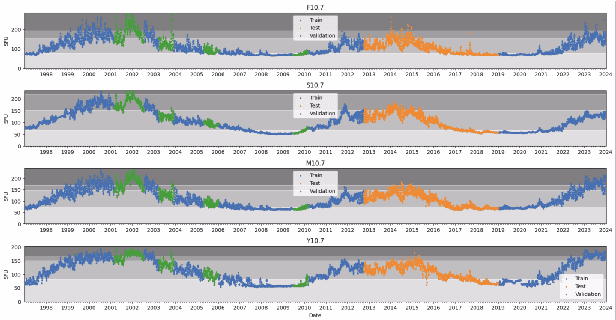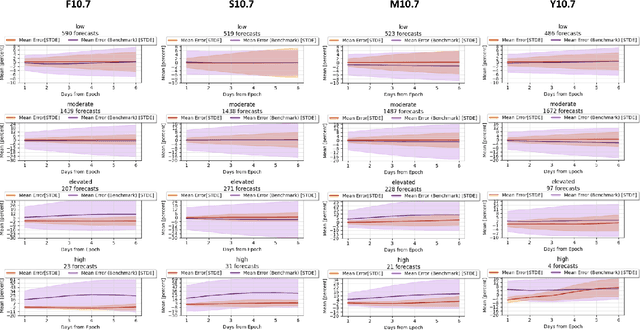Richard Linares
Action Chunking with Transformers for Image-Based Spacecraft Guidance and Control
Sep 04, 2025Abstract:We present an imitation learning approach for spacecraft guidance, navigation, and control(GNC) that achieves high performance from limited data. Using only 100 expert demonstrations, equivalent to 6,300 environment interactions, our method, which implements Action Chunking with Transformers (ACT), learns a control policy that maps visual and state observations to thrust and torque commands. ACT generates smoother, more consistent trajectories than a meta-reinforcement learning (meta-RL) baseline trained with 40 million interactions. We evaluate ACT on a rendezvous task: in-orbit docking with the International Space Station (ISS). We show that our approach achieves greater accuracy, smoother control, and greater sample efficiency.
Large Language Models as Autonomous Spacecraft Operators in Kerbal Space Program
May 26, 2025Abstract:Recent trends are emerging in the use of Large Language Models (LLMs) as autonomous agents that take actions based on the content of the user text prompts. We intend to apply these concepts to the field of Control in space, enabling LLMs to play a significant role in the decision-making process for autonomous satellite operations. As a first step towards this goal, we have developed a pure LLM-based solution for the Kerbal Space Program Differential Games (KSPDG) challenge, a public software design competition where participants create autonomous agents for maneuvering satellites involved in non-cooperative space operations, running on the KSP game engine. Our approach leverages prompt engineering, few-shot prompting, and fine-tuning techniques to create an effective LLM-based agent that ranked 2nd in the competition. To the best of our knowledge, this work pioneers the integration of LLM agents into space research. The project comprises several open repositories to facilitate replication and further research. The codebase is accessible on \href{https://github.com/ARCLab-MIT/kspdg}{GitHub}, while the trained models and datasets are available on \href{https://huggingface.co/OhhTuRnz}{Hugging Face}. Additionally, experiment tracking and detailed results can be reviewed on \href{https://wandb.ai/carrusk/huggingface}{Weights \& Biases
Fine-Tuned Language Models as Space Systems Controllers
Jan 28, 2025Abstract:Large language models (LLMs), or foundation models (FMs), are pretrained transformers that coherently complete sentences auto-regressively. In this paper, we show that LLMs can control simplified space systems after some additional training, called fine-tuning. We look at relatively small language models, ranging between 7 and 13 billion parameters. We focus on four problems: a three-dimensional spring toy problem, low-thrust orbit transfer, low-thrust cislunar control, and powered descent guidance. The fine-tuned LLMs are capable of controlling systems by generating sufficiently accurate outputs that are multi-dimensional vectors with up to 10 significant digits. We show that for several problems the amount of data required to perform fine-tuning is smaller than what is generally required of traditional deep neural networks (DNNs), and that fine-tuned LLMs are good at generalizing outside of the training dataset. Further, the same LLM can be fine-tuned with data from different problems, with only minor performance degradation with respect to LLMs trained for a single application. This work is intended as a first step towards the development of a general space systems controller.
Visual Language Models as Operator Agents in the Space Domain
Jan 14, 2025Abstract:This paper explores the application of Vision-Language Models (VLMs) as operator agents in the space domain, focusing on both software and hardware operational paradigms. Building on advances in Large Language Models (LLMs) and their multimodal extensions, we investigate how VLMs can enhance autonomous control and decision-making in space missions. In the software context, we employ VLMs within the Kerbal Space Program Differential Games (KSPDG) simulation environment, enabling the agent to interpret visual screenshots of the graphical user interface to perform complex orbital maneuvers. In the hardware context, we integrate VLMs with robotic systems equipped with cameras to inspect and diagnose physical space objects, such as satellites. Our results demonstrate that VLMs can effectively process visual and textual data to generate contextually appropriate actions, competing with traditional methods and non-multimodal LLMs in simulation tasks, and showing promise in real-world applications.
Diffusion Policies for Generative Modeling of Spacecraft Trajectories
Jan 01, 2025Abstract:Machine learning has demonstrated remarkable promise for solving the trajectory generation problem and in paving the way for online use of trajectory optimization for resource-constrained spacecraft. However, a key shortcoming in current machine learning-based methods for trajectory generation is that they require large datasets and even small changes to the original trajectory design requirements necessitate retraining new models to learn the parameter-to-solution mapping. In this work, we leverage compositional diffusion modeling to efficiently adapt out-of-distribution data and problem variations in a few-shot framework for 6 degree-of-freedom (DoF) powered descent trajectory generation. Unlike traditional deep learning methods that can only learn the underlying structure of one specific trajectory optimization problem, diffusion models are a powerful generative modeling framework that represents the solution as a probability density function (PDF) and this allows for the composition of PDFs encompassing a variety of trajectory design specifications and constraints. We demonstrate the capability of compositional diffusion models for inference-time 6 DoF minimum-fuel landing site selection and composable constraint representations. Using these samples as initial guesses for 6 DoF powered descent guidance enables dynamically feasible and computationally efficient trajectory generation.
Tight Constraint Prediction of Six-Degree-of-Freedom Transformer-based Powered Descent Guidance
Jan 01, 2025Abstract:This work introduces Transformer-based Successive Convexification (T-SCvx), an extension of Transformer-based Powered Descent Guidance (T-PDG), generalizable for efficient six-degree-of-freedom (DoF) fuel-optimal powered descent trajectory generation. Our approach significantly enhances the sample efficiency and solution quality for nonconvex-powered descent guidance by employing a rotation invariant transformation of the sampled dataset. T-PDG was previously applied to the 3-DoF minimum fuel powered descent guidance problem, improving solution times by up to an order of magnitude compared to lossless convexification (LCvx). By learning to predict the set of tight or active constraints at the optimal control problem's solution, Transformer-based Successive Convexification (T-SCvx) creates the minimal reduced-size problem initialized with only the tight constraints, then uses the solution of this reduced problem to warm-start the direct optimization solver. 6-DoF powered descent guidance is known to be challenging to solve quickly and reliably due to the nonlinear and non-convex nature of the problem, the discretization scheme heavily influencing solution validity, and reference trajectory initialization determining algorithm convergence or divergence. Our contributions in this work address these challenges by extending T-PDG to learn the set of tight constraints for the successive convexification (SCvx) formulation of the 6-DoF powered descent guidance problem. In addition to reducing the problem size, feasible and locally optimal reference trajectories are also learned to facilitate convergence from the initial guess. T-SCvx enables onboard computation of real-time guidance trajectories, demonstrated by a 6-DoF Mars powered landing application problem.
DreamSat: Towards a General 3D Model for Novel View Synthesis of Space Objects
Oct 07, 2024


Abstract:Novel view synthesis (NVS) enables to generate new images of a scene or convert a set of 2D images into a comprehensive 3D model. In the context of Space Domain Awareness, since space is becoming increasingly congested, NVS can accurately map space objects and debris, improving the safety and efficiency of space operations. Similarly, in Rendezvous and Proximity Operations missions, 3D models can provide details about a target object's shape, size, and orientation, allowing for better planning and prediction of the target's behavior. In this work, we explore the generalization abilities of these reconstruction techniques, aiming to avoid the necessity of retraining for each new scene, by presenting a novel approach to 3D spacecraft reconstruction from single-view images, DreamSat, by fine-tuning the Zero123 XL, a state-of-the-art single-view reconstruction model, on a high-quality dataset of 190 high-quality spacecraft models and integrating it into the DreamGaussian framework. We demonstrate consistent improvements in reconstruction quality across multiple metrics, including Contrastive Language-Image Pretraining (CLIP) score (+0.33%), Peak Signal-to-Noise Ratio (PSNR) (+2.53%), Structural Similarity Index (SSIM) (+2.38%), and Learned Perceptual Image Patch Similarity (LPIPS) (+0.16%) on a test set of 30 previously unseen spacecraft images. Our method addresses the lack of domain-specific 3D reconstruction tools in the space industry by leveraging state-of-the-art diffusion models and 3D Gaussian splatting techniques. This approach maintains the efficiency of the DreamGaussian framework while enhancing the accuracy and detail of spacecraft reconstructions. The code for this work can be accessed on GitHub (https://github.com/ARCLab-MIT/space-nvs).
Compositional Diffusion Models for Powered Descent Trajectory Generation with Flexible Constraints
Oct 05, 2024Abstract:This work introduces TrajDiffuser, a compositional diffusion-based flexible and concurrent trajectory generator for 6 degrees of freedom powered descent guidance. TrajDiffuser is a statistical model that learns the multi-modal distributions of a dataset of simulated optimal trajectories, each subject to only one or few constraints that may vary for different trajectories. During inference, the trajectory is generated simultaneously over time, providing stable long-horizon planning, and constraints can be composed together, increasing the model's generalizability and decreasing the training data required. The generated trajectory is then used to initialize an optimizer, increasing its robustness and speed.
Fine-tuning LLMs for Autonomous Spacecraft Control: A Case Study Using Kerbal Space Program
Aug 16, 2024Abstract:Recent trends are emerging in the use of Large Language Models (LLMs) as autonomous agents that take actions based on the content of the user text prompt. This study explores the use of fine-tuned Large Language Models (LLMs) for autonomous spacecraft control, using the Kerbal Space Program Differential Games suite (KSPDG) as a testing environment. Traditional Reinforcement Learning (RL) approaches face limitations in this domain due to insufficient simulation capabilities and data. By leveraging LLMs, specifically fine-tuning models like GPT-3.5 and LLaMA, we demonstrate how these models can effectively control spacecraft using language-based inputs and outputs. Our approach integrates real-time mission telemetry into textual prompts processed by the LLM, which then generate control actions via an agent. The results open a discussion about the potential of LLMs for space operations beyond their nominal use for text-related tasks. Future work aims to expand this methodology to other space control tasks and evaluate the performance of different LLM families. The code is available at this URL: \texttt{https://github.com/ARCLab-MIT/kspdg}.
Enhancing Solar Driver Forecasting with Multivariate Transformers
Jun 22, 2024


Abstract:In this work, we develop a comprehensive framework for F10.7, S10.7, M10.7, and Y10.7 solar driver forecasting with a time series Transformer (PatchTST). To ensure an equal representation of high and low levels of solar activity, we construct a custom loss function to weight samples based on the distance between the solar driver's historical distribution and the training set. The solar driver forecasting framework includes an 18-day lookback window and forecasts 6 days into the future. When benchmarked against the Space Environment Technologies (SET) dataset, our model consistently produces forecasts with a lower standard mean error in nearly all cases, with improved prediction accuracy during periods of high solar activity. All the code is available on Github https://github.com/ARCLab-MIT/sw-driver-forecaster.
 Add to Chrome
Add to Chrome Add to Firefox
Add to Firefox Add to Edge
Add to Edge